The first thing to do is sketch it out visually as a tree:

If you look at the left child (subtract, multiply / 4, etc) you see it is also a tree; and so is the left half of that (multiply, 2 / add, etc).
In fact, you can think of each node with its descendants as being a tree, consisting of either (a) an operator, with a left sub-tree and right sub-tree, or (b) a value (leaf node, no more descendants).
to evaluate a tree:
if it is a value:
you have the final value; return it
otherwise, it is an operator:
evaluate the left sub-tree
evaluate the right sub-tree
do operation(left-tree-value, right-tree-value)
return the result
You will notice that 'evaluate tree' calls itself to operate on the sub-trees - this is recursion, where solving a problem depends on solving smaller versions of the same problem and then combining the results.
So the final evaluation order looks like:
what is tree value?
add: {tree1} + {tree2}
what is tree1?
subtract: {tree3} - {tree4}
what is tree3?
multiply: {tree5} * {tree6}
what is tree5?
2
what is tree6?
add: {tree7} + {tree8}
what is tree7?
1
what is tree8?
3
add: 1 + 3
4
multiply: 2 * 4
8
what is tree4?
4
subtract: 8 - 4
4
what is tree2?
5
add: 4 + 5
9
